2018 Mahindra Thar vs Force Gurkha comparison
We pitch the Mahindra Thar CRDe against Force Motors’ Gurkha Explorer to see which one lives to tell the trail.
Published on Feb 19, 2018 11:04:00 AM
1,09,532 Views
Follow us on

The Mahindra's seat is the one you want when you are on the highway.
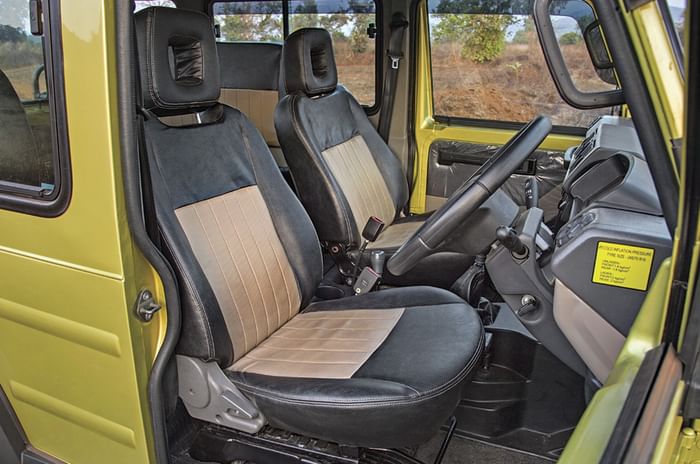
Fantastic visibility from Gurkha’s driving seat.
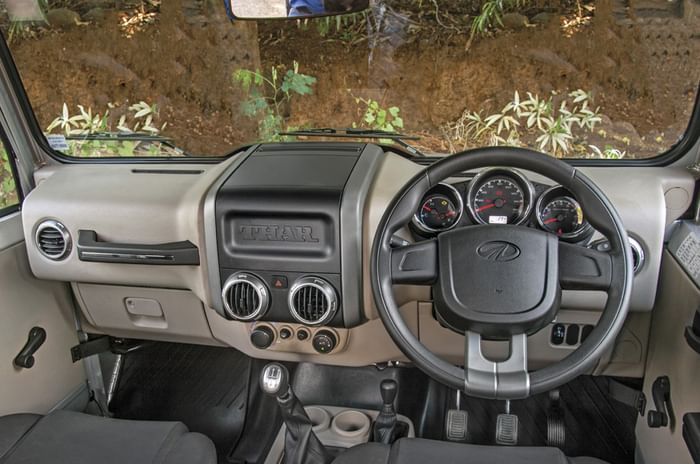
The Thar’s dashboard, in comparison to the Gurkha, looks premium, but is less user-friendly.
To kick off this story, think back to the days when Mahindra launched the Thar in 2010. It was a time when off-roading was for a few hardcore enthusiasts running around in very simple, noisy, leaf-sprung Mahindras and Gypsys. The Thar, with its air conditioning, power steering, independent front suspension, strong engine and factory warranty, was a revelation. This lookalike of what was originally supposed to be a workhorse brought off-roading to the masses. In the Thar, they found an almost everyday car. If you could put up with its soft-top limitations, and the bit of ribbing from the off-road crowd, it would easily tackle all the weekend trails you could throw at it.
The fly in the Thar’s ointment was a legend called the Gurkha. Though it was launched in 2008, it was only in 2013 that Force Motors decided to give it a serious makeover. The new Gurkha proved to be a very capable beast, but with so few dealerships to support it and with a Flintstones sort of crudeness to it, there were few takers. Force Motors initially sold about 30 units, and because that vehicle was capable and rarer than a Ferrari in India, 4x4 videos made it a legend. Adding to its shine was the decision to sign up with a factory team for the Rain Forest Challenge.
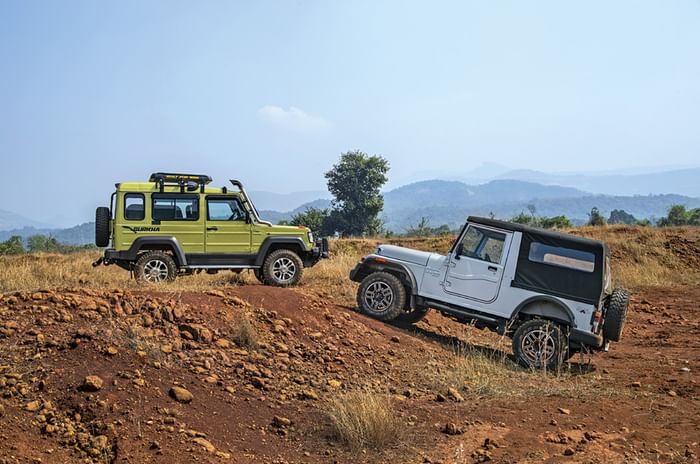
Force Motors decided it needed to be revived and that’s what happened in February last year. The team went back to the drawing board and came up with this new chest thumper. It swapped the direct-injection for a common-rail and put in a new gearbox and suspension. And you know what it is with chest thumpers? They need competition.
| Mahindra Thar Price, Mileage, Specifications, Features and Variants | |
|---|---|
| Brand | Mahindra |
| Model Name | Thar |
| Mahindra Thar Price | ₹ 11.46 - 19.37 lakh |
| Mahindra Thar Range/Mileage | Petrol : 15.2kpl | Diesel : 15.2kpl |
| Mahindra Thar Specifications | SUV | 3 doors | 4 seats View All Specs |
| Mahindra Thar Features | Halogen headlight | 7-inch Touchscreen display | 2 airbags View All Features |
| Mahindra Thar Variants | 1.5 Diesel MT AX (O) 4x2 Hard Top | 1.5 Diesel MT LX 4x2 Hard Top | 2.0 Petrol AT LX 4x2 Hard Top View All Variants |
ON TEST, OFF-ROAD
This test then is the two-and-a-quarter-door Thar CRDe against the new three-door Gurkha Explorer.
While the Thar evokes the classic ‘Jeep’ look, the Gurkha’s lines and flat panels are clearly inspired by the Mercedes G-Wagen. The bigger Gurkha, kitted out with all manner of accessories such as a roof-mounted shovel, an axe and a declaration that it’s ‘Built for War’, is hard to ignore. So let the battle begin.
Let’s jump in the deep end and talk about how they are off-road. Our test track today is an off-road trail in Khopoli. The trail would rate medium in difficulty rather than extreme, and, yet, it has enough challenges to separate the pretenders from the real McCoys. The trail will tell.
The Thar has the higher power figures. Its 2.5-litre common-rail diesel engine puts out 107hp of power and 247Nm of torque, and is mated to a five-speed manual transmission. The Gurkha comes with a 2.6-litre common-rail diesel engine that puts out 85hp of power and 230Nm of torque with a five-speed manual transmission. The Gurkha’s lower power figures are even more compromised when you consider its 2,050kg weight, against the Thar’s 1,750kg kerb weight.

But, to claw back the advantage, the Gurkha comes with manual locking differentials on the front and rear axles. The Thar has had a mechanical (read automatically) locking differential on the rear axle since 2015. The diff-lock engages in low-traction situations when a wheel speed difference of 100rpm or greater is detected across the axle. But, since you can’t engage the lock manually, it is difficult to control when the differential actually engages. Over a rock crawl, for example, you would want crawling ability and the mechanically locking differential simply doesn’t allow you that. By the time you get that 100rpm wheel speed difference and lock the diff, you’ve given too much throttle and the Thar will jump off where it is stuck rather than crawl off it. You then tend to hit the next rock hard and that is not good. In the Gurkha, you engage the diff-lock as and when you need and this gives you greater control. Engaging and disengaging the diff-locks can be a bit of a wrestle with the lever as we discovered, but then again, this is a bit easier than wrestling with an expensive repair bill, yes?
The manual control along with the Gurkha’s low idle speed gives it better crawling ability. The high idling motor in the Thar makes it run rather than step over difficult terrain and this is a vice.
The Gurkha also enjoys an extra 10mm ground clearance over the Thar – 210mm against 200mm. But anyone who has been off-road knows what matters more are approach, departure and the ramp over angles. The Thar has a 44-degree approach angle and 27-degree departure angle with a ramp-over angle of 15 degrees. The Gurkha, on the other hand, has a 39-degree approach angle and 27-degree departure angle with a ramp-over angle of 24 degrees. And that 24 degrees are important – you might bend the Gurkha’s bumpers but you will end up beached over a crest far fewer times than in a Thar.
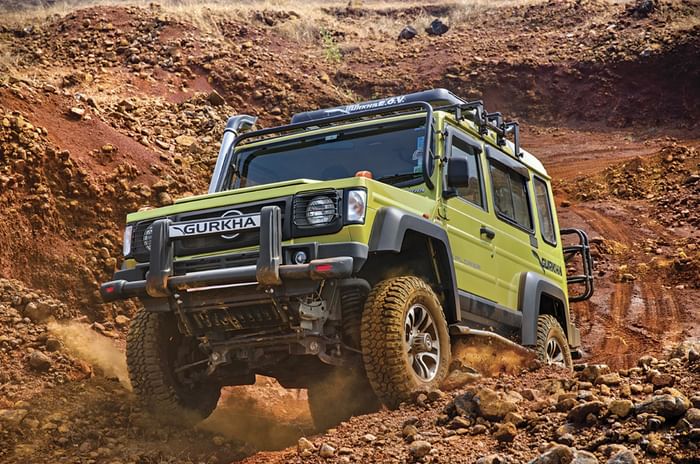
The Gurkha also beats the Thar when it comes to fording through water, thanks to its factory-fitted snorkel. The only off-road conditions where the Mahindra really claws back an advantage is in deep sand and up steep slopes. The power advantage will help it charge up shifty sand and slopes (remember to lower tyre pressures) where the Gurkha will wheeze.
The Gurkha has the edge when it comes to off-roading but that’s not to say that the Thar is less capable. After spending a whole day behind the wheel of both these vehicles, we would say that most drivers would find them evenly matched. It’s only in the most hardcore off-roading conditions that the Gurkha’s strengths are truly highlighted.
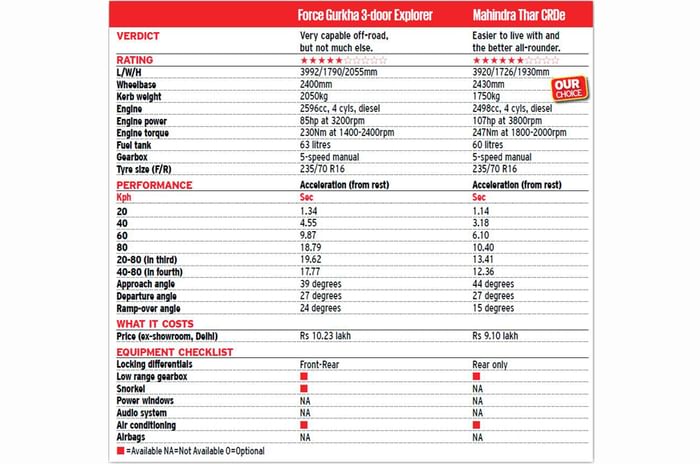
ON TEST, ON-ROAD
The Thar is the easier vehicle to live with – it’s got more power, the gearshift is not guesswork like the Gurkha’s and the clutch is lighter. Your leg won’t hurt as much while you try to look cool stuck in one of Mumbai’s legendary rush-hour traffic snarls.
But you are more comfortable in the Gurkha, which rides better (thanks to the independent front and multilink setup at the rear) and comes with a hardtop. The cabin’s quieter than the Thar. The constant flutter from the Thar’s soft-top is a deal-breaker if you are going to spend a lot of time on the highway.
Yes, you can get an aftermarket hardtop but then that’s extra money. While the Gurkha’s cabin is quieter, it looks like a leftover from the 1980s. The switches and controls, however, are much more ergonomically placed than on the Thar. If you want to engage four-wheel drive in the Mahindra, you have to bend down under the dash. It’s got the more premium-looking dash though. But fit and finish on both the vehicles are nothing to write home about. The only concessions to creature comforts are the air conditioning and power steering.
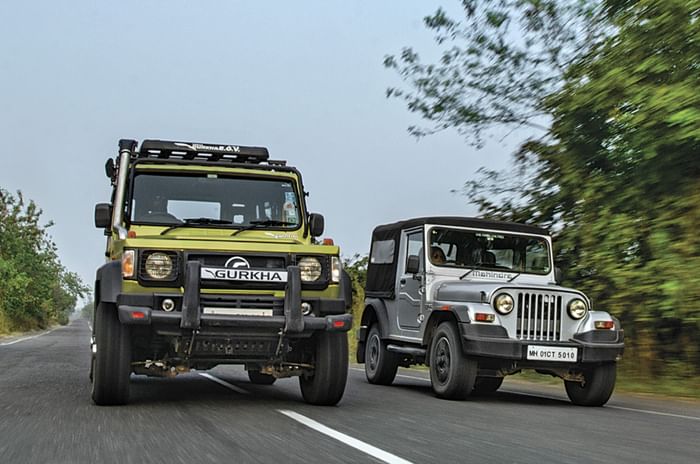
In the end, it all depends on what you want and we are literally forced to sit on the fence here. If you want the iconic looks and you don’t really want to cross the Darién Gap, the Thar is what you should close your eyes and buy because it is the easier one to live with. You’ll find a workshop or a mechanic somewhere close to wherever and whenever you break it. It has the ‘Jeep’ image and you’ll be a fan of its wider range of abilities. However, if you really want to cross that dense jungle infested with guerrillas and crocodiles and you are the Indiana Jones or Bear Grylls kind of person, the Force will be with you.
The Thar and the Gurkha might be the last of their kind. With the new safety norms kicking in by 2020, the companies will need to engineer major changes. The mandatory airbag and ABS requirements will add weight and complexity to these vehicles which are built around bare-boned simplicity. The next generation of Thar and Gurkha are sure to be completely different animals. Good or bad, we will be there to report it.
Copyright (c) Autocar India. All rights reserved.


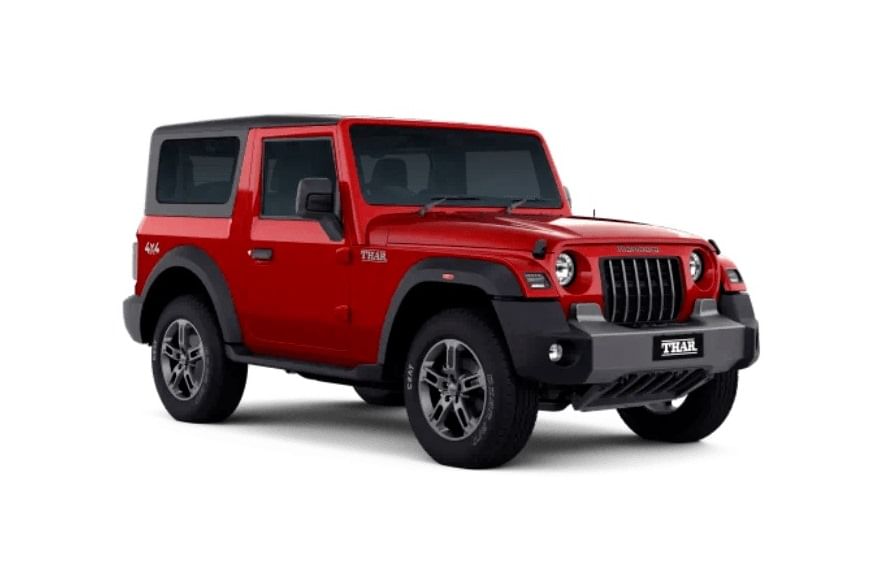



Comments
Member Login
Personal Details
No comments yet. Be the first to comment.